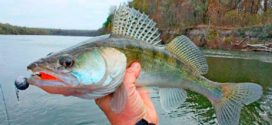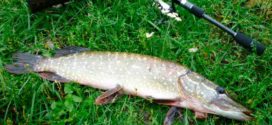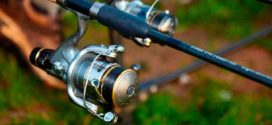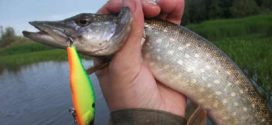One of the conditions for successful fishing is a competent selection of equipment, the main of which is fishing line. It is she who can withstand the maximum load, and if her choice is made correctly, then a cliff can be only in rare cases, as a rule, through the fault of the fisherman himself. Fans of this type of recreation prefer a float fishing rod. Let's figure out which fishing line is best for her.
Perhaps the reader, looking for an unambiguous answer to this question, will be disappointed - it simply does not exist. The fact is that fishing lines are different, and they differ in many ways. But the very process of fishing with a float rod has its own nuances - local conditions, the type of fish that is being fished for, and a number of others. Only considering all this in a complex, you can make the best choice and minimize the likelihood of a break.
Content
Types of fishing line for fishing rods
Wicker
Pros:
- Good sensitivity. The braided line almost instantly reacts even to slight fluctuations of the bait. It is highly appreciated by fishermen, especially beginners.
- This type of fishing line does not stretch, so there will be no problems with hooking large fish.
- The highest durability. According to this characteristic, the braided line is superior to other available analogues.
Minuses
- Over time, the fishing line "furs". And this is fraught with the formation of so-called "beards". Therefore, there is no need to talk about long-term use (if fishing is carried out often).
- Braided fishing line can cut your hands if overstressed. How relevant this is for a float fishing rod, everyone will determine for themselves.
- In clear water, this line is quite noticeable. This means that you will have to specially paint for a specific reservoir, otherwise it is difficult to count on a good catch. There are many simple techniques, but not everyone has the desire to do this.
- The most expensive line option. It is the beginners who mainly pay attention to this.
Fluorocarbon
Pros:
- In water, such a fishing line is almost invisible.
- Sold in various versions - transparent or tinted.
Minuses:
- "Memory". This fishing line is not elastic enough, therefore, along the entire length, it retains all the bends (when winding on reels) or the shape of the reel drum for a long time. It will take some time for the fish to fully straighten out in the process of catching fish. Consequently, it is quite often confused when casting, especially if the float rod is in inept hands.
- In terms of strength, such a fishing line is inferior to all other types.
- The cost is quite high, which "scars" many buyers.
monofilament line
Pros:
- When casting, this line, as a rule, does not get tangled, even if the rod is taken in hand for the first time.
- Average characteristics, which is quite enough for most anglers.
- Minimum abrasion. If a reservoir with a rocky bottom is chosen for fishing, this is an important factor.
- The low price of monofilament also makes it one of the best.
Minuses:
- "Sensitivity" is not on the level. Fishing with a float rod equipped with such a fishing line is not very convenient. Practice shows that beginners simply do not notice about half of the cautious bites.
- Elasticity. In the water, the monofilament stretches, which creates additional difficulties for the fisherman.
For feeder fishing, experienced anglers prefer mono-line .
Recommendations for choosing a fishing line
This applies not only to float, but also to any other fishing rod.
The main criterion is the optimal combination of the density of the fishing line and its thickness. It should be as invisible as possible in the water, therefore thinner. But at the same time, the strength of the equipment also decreases. For float rods, depending on the specifics of fishing (type of fish, standing water or running water, and so on), the recommended line diameter (mm) is within 0.12 - 0.2. In this case, you need to consider whether a leash will be placed or not. Inexperienced anglers often neglect them. Therefore, when catching a fairly large fish, it is advisable to focus on a fishing line of at least 0.3 - 0.4. Elasticity of the material of the fishing line. This has already been said, so it’s easy to determine which one to choose depending on the characteristics of fishing and the skill of the fisherman.Helpful Hints
The bulk of amateur fishermen focus on crucian carp. It is he who is most often found in most of our reservoirs, and in a fair amount. Therefore, the word "fishing" is mainly associated with it.
When choosing a fishing line for him, you need to consider the following points:
- It should be invisible in the water, as this fish is extremely shy.
- Recommended diameter - 0.18; maximum (for large bottom carp) - 0.25. Enough for a float rod.
- If you are too lazy to paint the line for masking (or there is no experience in this matter), then it is better to equip the float fishing rod with a fluorocarbon one, with a shade corresponding to the conditions of the reservoir. Although it does not differ in high strength, it will withstand crucian carp, even large ones.
No less popular with us is the "hunt" for carp. This fish is much larger than crucian carp, and its character is rather skittish, so surprises cannot be avoided when playing. What to focus on?
- Diameter - not less than 0.2. Even a small carp, given its strength and activity, will easily break a thinner fishing line on a fishing rod. If there are a lot of algae in the reservoir, then 0.3.
- For a float fishing rod with a reel, experienced fishermen advise purchasing a braided line with a cross section of 0.4 - 0.6. But this is for big fish. By the way, carp are caught mainly with such fishing rods. Flywheels are of little use for this.
For lovers of catching small fish (for example, bream, perch, rudd, roach), a fishing line with a cross section of more than 0.2 mm is unlikely to come in handy. As a rule, its thickness of 0.15 is enough.
Hello, I am Alexander, the mastermind behind the blog.
In terms of career and free time, I connected my life with the forest. How else, when you live in Karelia! In this blog, I am responsible for the hunting, hiking and equipment sections. Welcome to my world!
 Survival Lessons Tips for the survivalist, fisherman and hunter
Survival Lessons Tips for the survivalist, fisherman and hunter





